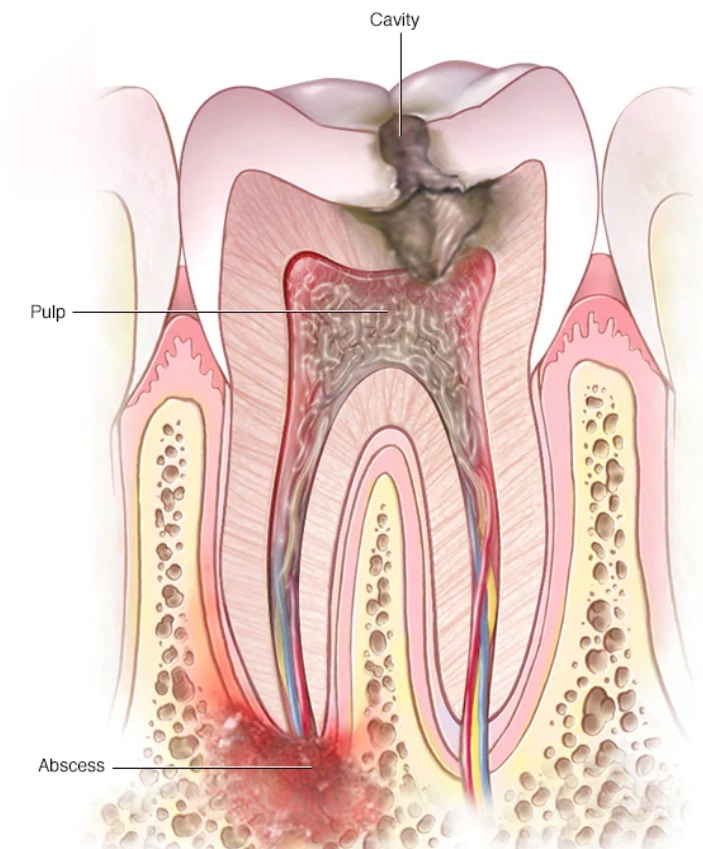Ask the Experts
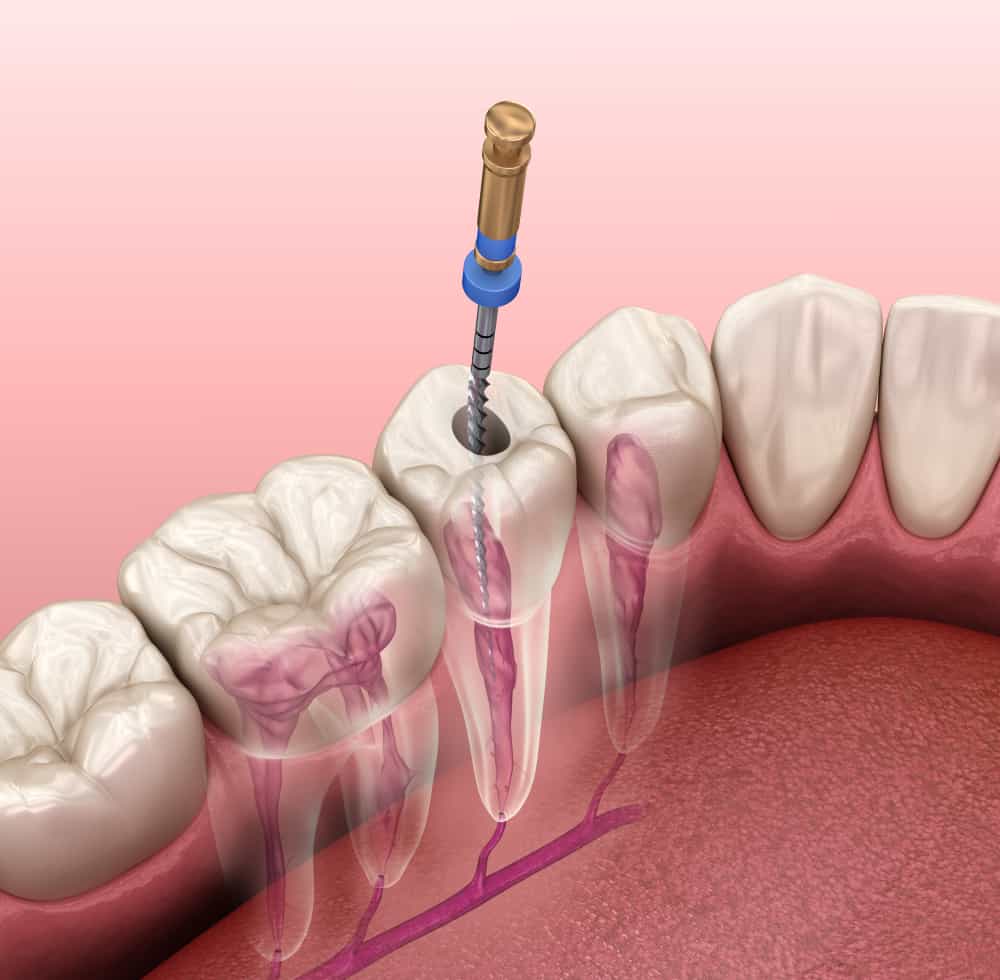
Root Canal Treatment (RCT)
Root canal treatment is designed to eliminate bacteria from the infected root canal, prevent reinfection of the tooth and save the natural tooth. When one undergoes a root canal, the inflamed or infected pulp is removed and the inside of the tooth is carefully cleaned and disinfected, then filled and sealed.
What is root canal treatment?
There’s no need to be worried if you are advised for a root canal procedure to treat a damaged or diseased tooth. Millions of teeth are treated and saved this way each year, relieving pain and making teeth healthy again. It is to be known here that root canal treatment is a specialized procedure to be carried out by a qualified root canal specialist.
Inside your tooth, beneath the white enamel and a hard layer called dentin, is a soft tissue called the pulp. This tissue contains blood vessels, nerves, and connective tissue, which help grow the root of your tooth during its development. A tooth can survive without the pulp because it is nourished by surrounding tissues.
A modern root canal treatment is nothing like those old sayings! It’s very similar to a routine filling and can usually be completed in one or two appointments, depending on the condition of your tooth and your personal circumstances. Getting a root canal is relatively painless and extremely effective. You’ll be back to smiling, biting, and chewing with ease in no time.
Saving the natural tooth with root canal treatment has many advantages:
- Efficient chewing
- Normal biting force and sensation
- Natural appearance
- Protects other teeth from excessive wear or strain
All about Root Canals
A root canal (also known as an endodontic treatment) is a serious procedure, but one that specialists (MDS, Endodontics) handle every day. Before engaging in any type of dental work, it’s important to know the facts about root canals.
Steps of a root canal procedure
A root canal procedure is relatively simple. The dentist needs to clean out the infected pulp and fill the canals. Patients usually need a temporary crown after the procedure. Go over each of the steps.
Preparing the area
The dentist begins by numbing the area. Injections are used to send the numbing agent into the gums and the tooth’s root. Once the area is numbed, the dentist re confirms that you don’t feel any sensation or pain in the area in which he is working.
Accessing and cleaning the roots
Next, the dentist drills through the tooth to access the root canals and pulp chamber. The dentist uses instruments to clean out the pulp chamber and root canals. An antibacterial and antiseptic solution is used to clean and disinfect the canals. This eliminates the bacteria and treats the infection located in the canals.
Shaping the canals
The dentist must place a filling in the root canals. First, the canals must be shaped. The dentist will use tiny instruments to shape the canals, so they will be ready to receive the filling material. Once shaped, the canals are cleaned a second time.
Filling the canals
The dentist will use gutta-percha to fill the canals. This rubber-like material is placed inside the canals and then heated. The dentist compresses it, so it fits snuggly against the walls. The dentist adds adhesive cement to further seal the canals. Properly sealed canals keep bacteria out.
Filling to the access hole
The dentist must also seal the hole made to access the canals. The filling prevents bacteria from entering the tooth. The dentist also might need to place a post in a canal to strengthen the tooth. This is only necessary if the tooth is severely damaged and cannot support a restoration on its own.
Healing and antibiotics
The dentist might send the patient home with a prescription for antibiotics. The medication kills the rest of the infection. The patient will also have post-care instructions. It is normal to experience some discomfort for a few days after the procedure. Over-the-counter pain medications usually alleviate the discomfort.
Adding the crown
If the root canal was on the back tooth or the tooth has significant damage, the patient will need to come back for a crown. The crown is placed around the treated tooth and adds strength and stability. The permanent crown is fabricated to match the existing teeth. Once placed, the tooth can handle the forces of chewing once again.
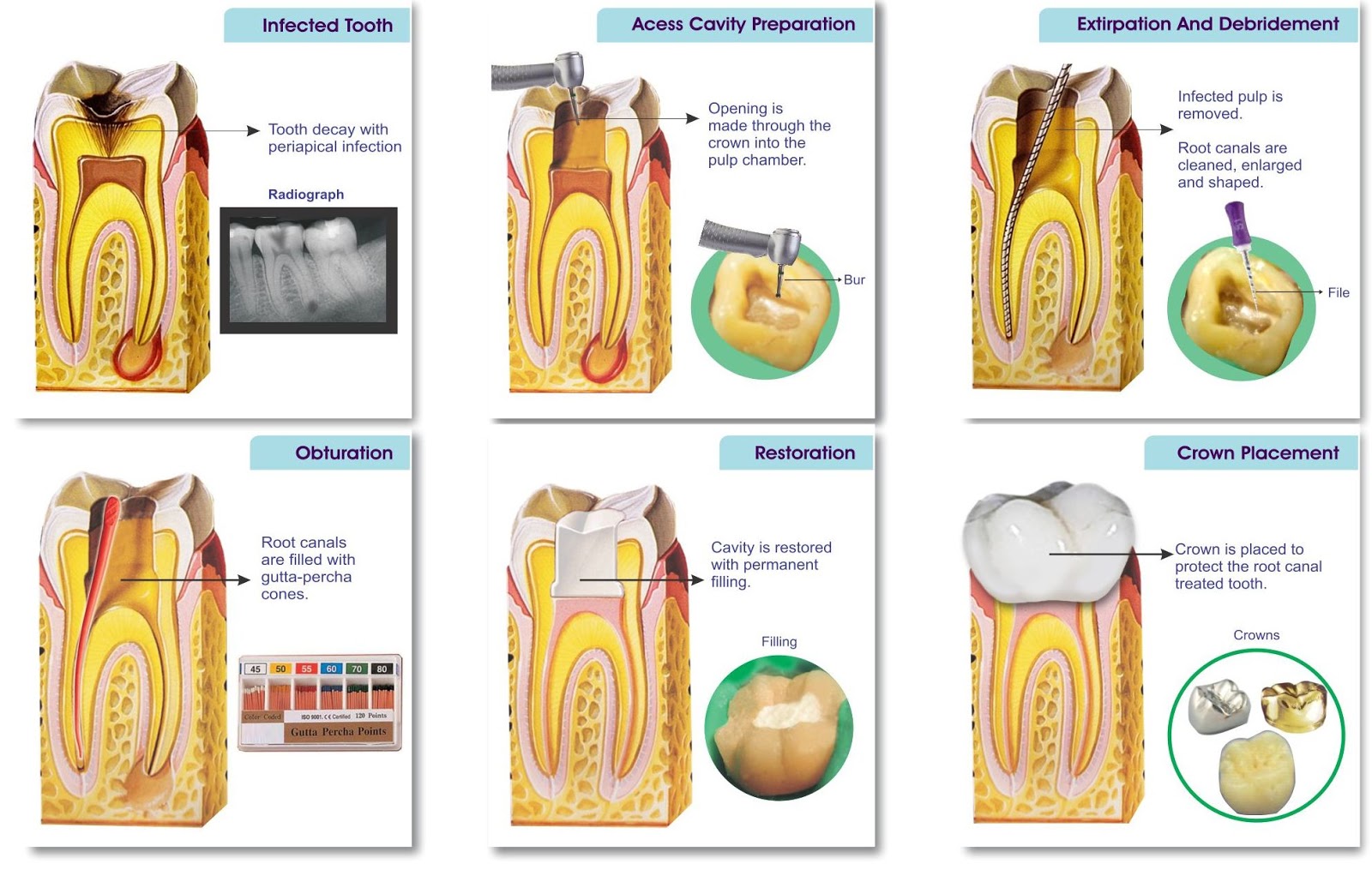
How does endodontic treatment save the tooth?
It’s necessary to have endodontic or root canal treatment when the inside of your tooth (the pulp) becomes inflamed or infected as a result of deep decay, repeated dental procedures, faulty crowns or a crack or chip in the tooth. Trauma to your tooth may also cause pulp damage even if the tooth has no visible chips or cracks. If pulp inflammation or infection is left untreated, in can cause pain or lead to an abscess.
When you undergo a root canal or other endodontic treatment, the inflamed or infected pulp is removed and the inside of the tooth is carefully cleaned and disinfected, then filled and sealed with a rubber-like material called gutta-percha. Afterwards, the tooth is restored with a crown or filling for protection and will continue to function like any other tooth.
Endodontic treatment helps you maintain your natural smile, continue eating the foods you love and limits the need for ongoing dental work. With proper care, most teeth that have had root canal treatment can last a lifetime.
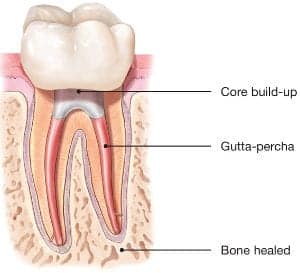
Advanced Rotary Endodontics:
At Niramaya Multispeciality Dental Hospital you will always find the latest in class technology dental equipments. Root canal procedure is also performed with the most advanced Endomotor, Digitial Apex locator, Ultrasonic Endo activator device, Digital RVG, DC Xray Unit, etc. devices. The use of these high tech devices allows a highly precise end result and also makes the root canal treatment more efficient and pain-free procedure. At our Niramaya Multispeciality Dental Hospital, you will witness a world class dentistry experience with our specialists.

Re- Root Canal Treatment:
A tooth that has been root treated can last many years, particularly if it is appropriately restored following root canal treatment. On occasion, teeth can fail to heal or become infected again. This can happen months or years after the original treatment. The tooth becomes painful and sometimes a gum boil can appear, sometimes there are no symptoms and the failure is only detected with an x-ray. Carrying out re-treatment can give the tooth a second chance.
Failure of a root canal treatment can happen for several reasons:
Most common:
- Bacteria (infection) remaining within the canals e.g missed or incompletely filled canals
- New bacteria have entered the root canal e.g through a lost or broken restoration (filling/crown/bridge), decay or root fracture
Less common:
- Infection has spread from within the root canal and into surrounding tissues
- A reaction to the filling materials placed beyond the root canal into the tissues surrounding tooth
- A cyst has developed at the end of the root (although often these will heal with root canal treatment)
Treatment:
Local anaesthetic is always used to numb the tooth. Access is made through the tooth into the root canal. The previous root filling is removed to allow any infected parts of the canals to be accessed and cleaned. Any other issues, such as missed and blocked canals or broken instruments, can be tackled at the same time. Once the root canals have been located, small files are used to clean and shape them together with copiously rinsing with disinfectants to remove any bacteria. If the cleaning and shaping of canals takes more than one visit, the tooth is dressed using an antibacterial paste within the canals and a temporary filling is placed.
Once the root canals are as clean as possible, they are filled and covered to protect them from bacteria re-entering. In some cases, the tooth will need to be restored with a more permanent restoration, such as a crown, to again prevent bacteria getting back in and causing the root treatment to fail.
Is it painful?
It will not be painful during the treatment, but you should expect mild discomfort for 2-3 days afterwards. This is best managed with a simple painkiller.
Alternatives to root canal treatment:
There are no alternatives if you wish to retain your tooth. The only other option is to have the tooth extracted. This will leave a gap you might be happy to accept, or you may want to look at options to fill gaps, which could include a denture, bridge or implant.
Factors which increase success:
- Treatment completed by a specialist (MDS, Endodontist)
- Being able to find all the root canals and clean, shape and fill them to the end of the roots
- Having a good quality permanent restoration placed as soon as possible after treatment. In the case of heavily filled back teeth, a crown is the restoration of choice. This increases the chance of tooth survival by 6 times.
Factors which decrease success:
- If there is a radiolucency (dark shadow) on the x-ray associated with the tooth
- If there is a sinus (gum boil) associated with the tooth
- If a large, longstanding perforation (communication through the root into the surrounding gum or bone) is present
- Where the root treated tooth is used to support a denture or bridge.
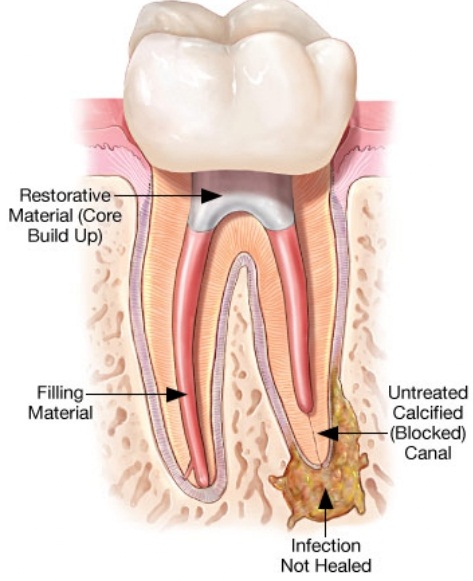
Post and Core after Root Canal Treatment:
Post and core is a dental restoration treatment that’s sometimes performed after a root canal. When a significant portion of a tooth’s structure is damaged, a post and core can help keep a dental crown in place. Dental crowns are put on top of teeth, to protect them from further damage or infection.
What is post and core?
In some instances when the tooth structure is damaged more than 50%, there may not be enough tooth left intact to return it to typical function.
When this occurs, a post and core can be performed to keep a dental crown in place, and to reconstruct, or build the missing portions of your tooth.
“In laymen’s terms, you cannot build strong house on a weak foundation to with stand forces,” says Dr. Sonam Nagar Pandit, MDS (Endodontist) “A post in dentistry is like a new extra foundation pole placed inside tooth to support the future crown.”
How is a post and core done?
Normally pre fabricated post & cores are used.
Pros and cons of post and core
Here are pros and cons of a post and core procedure.
Pros
- A post and core procedure allows you to retain your tooth, eliminating the need for an extraction and dental replacement, which may be costly.
Cons
- Post and core procedures don’t reinforce or strengthen teeth roots.
- In some instances, a post may stress or weaken your teeth over time.
In simple words
Post and core is a dental restoration procedure which is sometimes performed after a root canal. The purpose of a post and core is to salvage an existing tooth that has lost a significant amount of its internal structure.
A post and core helps anchor a dental crown on top of a tooth to shield it from infection and further damage.
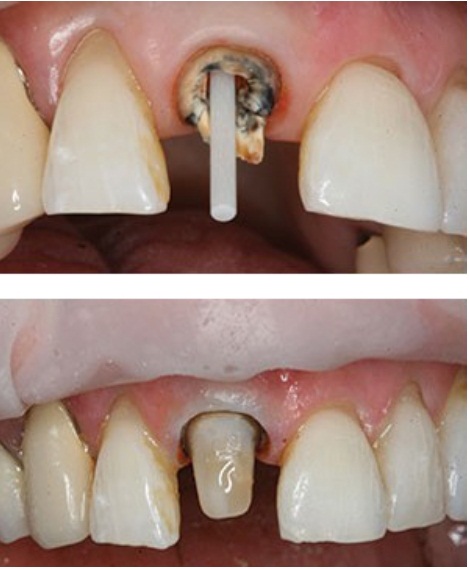
What are the advantages of the Root Canal?
Root canal treatment is a pain-free process and mostly leaves you with minimal discomfort during recovery as compared to having your natural tooth extracted. With advanced latest in class techniques that we use at Niramaya Multispeciality Dental Hospital patients experience is always painless & comforting as compared to have a tooth extracted. You could improve your smile and laugh with confidence again after a root canal treatment. By retaining your teeth you get to maintain the natural position and avoid any excessive wear or strain on the adjacent teeth or any of the teeth shifting. The appearance of your smile is way better when you manage to retain your natural teeth. Aesthetically it’s better than any type of replacement alternative.
Our Root canal specialist Dr Sonam Nagar Pandit is an Endodontist (MDS, Conservative Dentistry and Endodontics). She has completed 3 years of post graduation in the field of endodontics (Root Canal Treatment) & holds an experience of more than 10 years. She is a very well known name for performing complex root canal procedures; re-root canal procedures, broken instrument retrieval/ bypass in root canal, etc as a consultant too at various clinics & hospitals in and around Ujjain.
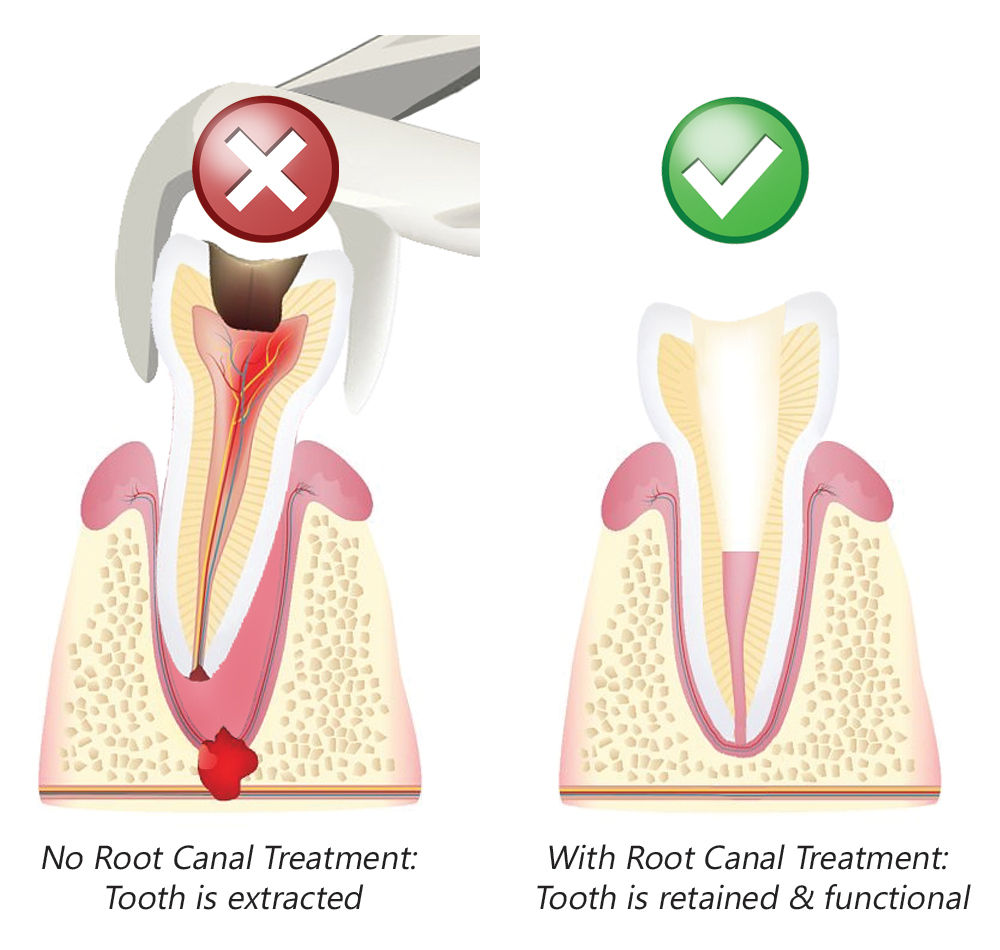
FAQ:-
1. Does a root canal hurt?
Since patients are given anesthesia, a root canal isn’t more painful than a regular dental procedure, such as a filling or getting a wisdom tooth removed. However, after root canal treatment side of treatment will be numb for a while and you are not supposed to eat from the treated site.
2. How do you know if you need a root canal?
Root canals are needed for a cracked tooth from injury or genetics, a deep cavity, or issues from a previous filling. Patients generally need a root canal when they notice their teeth are sensitive, particularly to hot and cold sensations. If you ignore the sensations it will lead to continued pain and swelling.
There are a few symptoms that mean you might need a root canal—
- Severe pain while chewing or biting
- Pimples on the gums
- A chipped or cracked tooth
- Lingering sensitivity to hot or cold, even after the sensation has been removed
- Swollen or tender gums
- Deep decay or darkening of the gums
3. Can I go to school or work after getting a root canal?
Although you will most likely be numb for 2-4 hours following the procedure, most patients are able to return to school or work directly following a root canal. However, it is advised against eating until the numbness is completely gone.
4. Can I Go for RCT during pregnancy?
Usually, 2nd Trimester means the 4th, 5th & 6th months are the safest months for the root canal treatment. If your general health is good and if your gynecologist permits, after her/his consent Root Canal treatment can be done.
5. How many sittings are required in RCT?
RCTs can be done in Single sitting or Multiple Sitting. It depends on the condition of the tooth and the grade of the infection. If you come to us in very early stage and infection is very less single sitting root canal can be done. A single sitting root canal takes proper expertise and time dedication so we suggest patients visit us at Niramaya by booking prior appointments so our root canal specialist can give you proper time for consultation and treatment.
If you are being suggested for multiple sitting root canal treatment means your grade of infection is high. So you need to visit multiple times on allotted appointments so that we can change the medicated dressings in root canal. Normally multiple sitting root canal need your 2 to 3 visits before completion. At Niramaya our Root canal specialist Dr Sonam Nagar Pandit, MDS is always there to provide you the best RCT experience.
6. Is capping necessary after Root Canal Treatment?
Due to infection tooth already becomes weak structurally thus capping is done post root canal treatment to avoid the tooth from getting fractured or damaged under masticatory forces. After root canal treatment tooth is shaped in a particular size, the impression is taken and the crown is fabricated.
7. What type of crown can I get?
- Metal Crowns
- Metal Ceramic Crowns
- CAD-CAM PFM Crowns
- DLMS Crowns
- Zirconia Crowns
Once your root canal treatment is done our dentists will advise you for the capping of the tooth. Capping can be done for single teeth and multiple teeth as well. After root canal bridging is also done to replace missing teeth. For more details on types of crowns please visit prosthodontics section.

